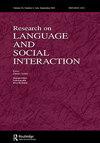概率与价:极性问题设计中的两种偏好及其管理
IF 2.1
1区 文学
Q1 COMMUNICATION
引用次数: 8
摘要
摘要本研究对Heritage和Raymond提出的论点进行了扩展和完善,证明了问题设计中的概率取向可以与第二种取向相交,即所调查的事物状态的积极或消极可取性或效价。在大多数情况下,概率和正价信息的方向可以同时满足:在通常避免负价信息的情况下,正极化的问题会带来“好消息”,而负极化的问题则指向“坏消息”场景。在极性问题设计和一系列互动环境中,这些一致的方向通常得到满足。然而,正如互动中各种其他同时相关的偏好所示,这些取向也可能相互冲突,从而揭示了它们之间的分层关系。具体而言,我们表明,当接受者设计的考虑需要对可能的和负面的事态提出问题时,对积极结果的倾向将减弱或放弃,而倾向于对负面事态的可能性采取“现实”的立场。因此得出结论,概率是极性问题接受者设计的一个更基本的方面,而不是信息效价。数据来源于英美英语会话的语料库。本文章由计算机程序翻译,如有差异,请以英文原文为准。
Probability and Valence: Two Preferences in the Design of Polar Questions and Their Management
ABSTRACT This study expands and refines the argument presented by Heritage and Raymond by demonstrating that the orientation to probability in question design can intersect with a second orientation toward the positive or negative desirability—or valence—of the state of affairs inquired into. In most cases, the orientations to probability and to positively valenced information can be satisfied simultaneously: In a context where negatively valenced information is generally avoided, positively polarized questions invite “good news,” and negatively polarized questions are directed to “bad news” scenarios. These congruent orientations are routinely satisfied in polar question design and in a range of interactional environments. However, as has been illustrated with various other concurrently relevant preferences in interaction, these orientations can also conflict with one another, thereby revealing a hierarchization between them. Specifically, we show that when considerations of recipient design require questions about states of affairs that are both likely and also negatively valenced, orientations to positive outcomes will be attenuated or abandoned in favor of a “realistic” stance toward the likelihood of the negative state of affairs. It is therefore concluded that probability is a more fundamental aspect of the recipient design of polar questions than is information valence. Data are drawn from corpora of British and American English conversations.
求助全文
通过发布文献求助,成功后即可免费获取论文全文。
去求助
来源期刊
CiteScore
7.30
自引率
7.40%
发文量
20
期刊介绍:
The journal publishes the highest quality empirical and theoretical research bearing on language as it is used in interaction. Researchers in communication, discourse analysis, conversation analysis, linguistic anthropology and ethnography are likely to be the most active contributors, but we welcome submission of articles from the broad range of interaction researchers. Published papers will normally involve the close analysis of naturally-occurring interaction. The journal is also open to theoretical essays, and to quantitative studies where these are tied closely to the results of naturalistic observation.

 求助内容:
求助内容: 应助结果提醒方式:
应助结果提醒方式:


